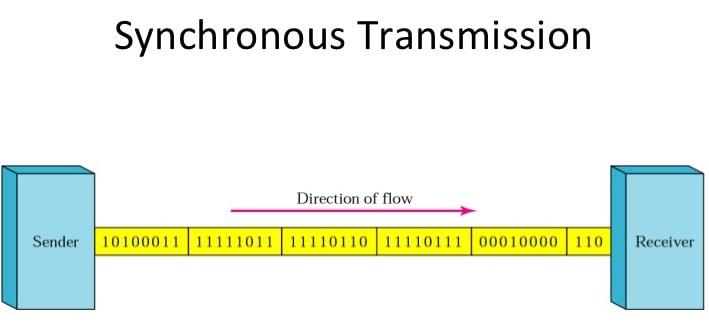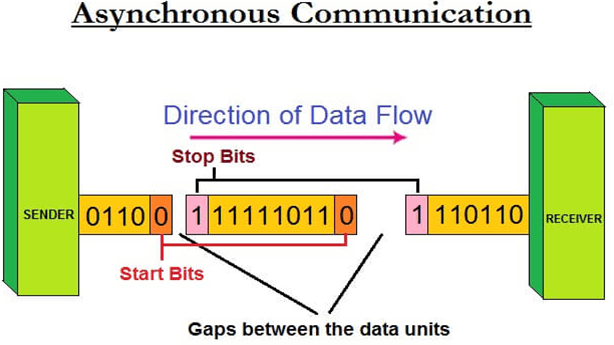When a data transmission media connect two devices, it requires data transfer. In this regard, the challenge of syncing with the receiving and sending equipment is common. Both Synchronous and Asynchronous Transmission are types of serial data transmission in digital electronics, in which data exchanges between sender and receiver based on the synchronization clock pulse.
At work, data transmission is crucial. Therefore, it’s necessary to understand the different types and how they perform under different conditions. This write-up will take you through the two methods’ differences in depth.
What is Synchronous Transmission?

The data transmit in active mode through blocks or frames in Synchronous Transmission. The transmitter and receiver must be in sync for the sender to know where the new byte begins. As a result, the synchronization characters are labeled on each block of characters. The data acquires by receiving equipment until a specific ending mark is discovered.
When huge amounts of data are transported quickly from one point to another, synchronous transmission mechanisms are used. Data delivers in huge chunks rather than individual characters to achieve a reasonable transmission speed. Before a vast file is transmitted, it gets split into blocks of sentences. It is then subsequently transported to the target site over a communication channel.
How does Synchronous Transmission work?
Independent clocking lines are utilized when the distance between the terminal data equipment and the data communications equipment is short. A clocking electrical system is used at both the transmitting and receiving stations. The communication process will be synced as a result of this. Separate clocking channels are used by devices that communicate with each other synchronously.
Synchronous Transmission Characteristics
- There are no gaps between the characters in the message.
- At the end of the transmission, routers offer timing.
- Before the data is transferred, specific ‘syn’ characters are sent.
- For timing purposes, the syn characters are placed between pieces of data.
Synchronous Transmission Examples
- Chat groups
- Conferencing via video
- Conversations on the phone
- Interactions with people in person
What is Asynchronous Transmission?

Moreover, Asynchronous Transmission sends data one byte or character simultaneously in a half-duplex method. It means the data is transmitted in a continuous stream of bytes. Generally, a character sent is 8 bits long plus a parity bit. So, it is a beginning and end bit that adds up to 10 bits. Furthermore, it employs character-based synchronization for the receiving terminal to synchronize with the receipt of data on a single character.
However, it is easy, quick, cost-effective, and does not require two-way communication. Besides, the asynchronous transfer uses narrow-band voice-band channels that operate at a reduced speed. In this case, the transmitting equipment is operated manually or infrequently.
How does Asynchronous Transmission work?
Two bits, known as the start bit as ‘0’ and the stop bit as ‘1,’ make asynchronous communication easier. To initiate the transmission, transmit the ‘0’ bit, and to halt it, send the ‘1’ bit. Between the communication of two bytes, there is a time delay. Nowadays, the transmitter and receiver use different clock frequencies.
Asynchronous Transmission Characteristics
- A beginning bit precedes each character, followed by one or more end bits.
- Between characters, there may be gaps or spaces.
- Asynchronous transmission does not require a clock signal.
- The use of the asynchronous transmission is simple and cost-effective.
Asynchronous Transmission Examples
- Emails
- Radio
- Letters
- Forums
- Television
Difference Between Synchronous and Asynchronous
| SYNCHRONOUS TRANSMISSION | ASYNCHRONOUS TRANSMISSION | |
| TRANSMISSION OF DATA | Data transfers in the form of blocks or frames in synchronous transmission | Data transfers in the form of bytes or characters in asynchronous transmission. |
| PERIOD GAPS | In synchronous transmission, the period gaps function as a constant. | Asynchronous transmission’s period gaps are chosen at random and change over time. |
| TRANSMISSION SPEED | In synchronous transmission, data transmit at a high rate. | In asynchronous transmission, data transmission speed is quite slow. |
| SIGNAL CLOCK | To notify the target of a new byte, synchronous transmission requires a clock signal between the source and the target. | A clock signal is not any condition in asynchronous transmission because the parity bit associated with the data transferred serves as a start signal for the next byte. |
| RELATIVITY | Synchronous transmission is straightforward to implement. | Asynchronous transmission, on the other hand, is complex in nature and design. |
Conclusion
All in all, synchronous transmission is preferable for transferring large data sets fast. On the other hand, asynchronous transmission is preferable for sending tiny amounts of data. Compared to asynchronous transmission, synchronous transmission is more systematic and requires smaller overhead values. As compared to asynchronous data transfer, synchronous data transmission is more dependable. In addition, both have their own set of limitations and advantages. Yet we need and use both in our devices to communicate effectively.